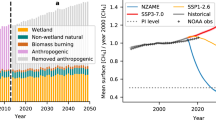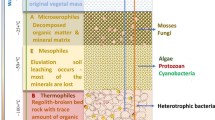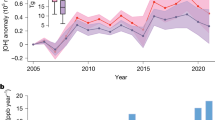Abstract
Methane emissions contribute to global baseline surface ozone concentrations; therefore reducing methane to address climate change has significant co-benefits for air quality and human health. We analyze the costs of reducing methane from 2005 to 2030, as might be motivated to reduce climate forcing, and the resulting benefits from lower surface ozone to 2060. We construct three plausible scenarios of methane emission reductions, relative to a base scenario, ranging from 75 to 180 Mton CH4 yr−1 decreased in 2030. Using compilations of the global availability of methane emission reductions, the least aggressive scenario (A) does not incur any positive marginal costs to 2030, while the most aggressive (C) requires discovery of new methane abatement technologies. The present value of implementation costs for Scenario B are nearly equal to Scenario A, as it implements cost-saving options more quickly, even though it adopts positive cost measures. We estimate the avoided premature human mortalities due to surface ozone decreases by combining transient full-chemistry simulations of these scenarios in a global atmospheric chemical transport model, with concentration-mortality relationships from a short-term epidemiologic study and projected global population. An estimated 38,000 premature mortalities are avoided globally in 2030 under Scenario B. As benefits of methane reduction are positive but costs are negative for Scenario A, it is justified regardless of how avoided mortalities are valued. The incremental benefits of Scenario B also far outweigh the incremental costs. Scenario C has incremental costs that roughly equal benefits, only when technological learning is assumed. Benefits within industrialized nations alone also exceed costs in Scenarios A and B, assuming that the lowest-cost emission reductions, including those in developing nations, are implemented. Monetized co-benefits of methane mitigation for human health are estimated to be $13–17 per ton CO2eq, with a wider range possible under alternative assumptions. Methane mitigation can be a cost-effective means of long-term and international air quality management, with concurrent benefits for climate.






Similar content being viewed by others
Explore related subjects
Discover the latest articles and news from researchers in related subjects, suggested using machine learning.References
Anenberg SC, West JJ, Fiore AM, Jaffe DA, Prather MJ, Bergmann D, Cuvelier C, Dentener FJ, Gauss M, Hess P, Jonson JE, Lupu A, MacKenzie IA, Marmer E, Park RJ, Sanderson M, Schultz M, Shindell DT, Szopa S, Vivanco MG, Wild O, Zeng G (2009) Intercontinental impacts of ozone pollution on human mortality. Environ Sci Technol 43:6482–6487
Anenberg SC, Horowitz LW, Tong DQ, West JJ (2010) An estimate of the global burden of anthropogenic ozone and fine particulate matter on premature human mortality using atmospheric modeling. Environ Health Perspect 118(9):1189–1195
Aunan K, Fang J, Heidi Elizabeth Staff Mestl D, O’Connor HM, Seip HV, Zhai F (2003) Co-benefits of CO2-reducing policies in China—a matter of scale? Int J Global Energ Issues 3(3):287–304
Aunan K, Fang JH, Vennemo H, Oye K, Seip HM (2004) Co-benefits of climate policy—lessons learned from a study in Shanxi, China. Energy Policy 32(4):567–581
Barker T, Bashmakov I, Alharthi A, Amann M, Cifuentes L, Drexhage J, Duan M, Edenhofer O, Flannery B, Grubb M, Hoogwijk M, Ibitoye FI, Jepma CJ, Pizer WA, Yamaji K (2007) Mitigation from a cross-sectoral perspective. In: Metz B, Davidson OR, Bosch PR, Dave R, Meyer LA (eds) Climate change 2007: Mitigation. Contribution of Working Group III to the Fourth Assessment Report of the Intergovernmental Panel on Climate Change. Cambridge University Press, Cambridge
Barrett SRH, Britter RE, Waitz IA (2010) Global mortality attributable to aircraft cruise emissions. Environ Sci Technol 44(19):7736–7742
Bell M, Dominici F (2006) Analysis of threshold effects for short-term exposure to ozone and increased risk of mortality. Epidemiology 17(6):S223–S223
Bell ML, McDermott A, Zeger SL, Samet JM, Dominici F (2004) Ozone and short-term mortality in 95 US urban communities, 1987–2000. JAMA 292(19):2372–2378
Bell ML, Dominici F, Samet JM (2005) A meta-analysis of time-series studies of ozone and mortality with comparison to the National Morbidity, Mortality, and Air Pollution Study. Epidemiology 16(4):436–445
Burtraw D, Krupnick A, Palmer K, Paul A, Toman M, Bloyd C (2003) Ancillary benefits of reduced air pollution in the US from moderate greenhouse gas mitigation policies in the electricity sector. J Environ Econ Manag 45(3):650–673
Cifuentes L, Borja-Aburto VH, Gouveia N, Thurston G, Davis DL (2001a) Climate change: hidden health benefits of greenhouse gas mitigation. Science 293(5533):1257–1259
Cifuentes L, Borja-Aburto VH, Gouveia N, Thurston G, Davis DL (2001b) Assessing the health benefits of urban air pollution reductions associated with climate change mitigation (2000–2020): Santiago, Sao Paulo, Mexico City, and New York City. Environ Health Perspect 109:419–425
Clarke LE, Wise M, Placet M, Izaurralde RC, Lurz JP, Kim SH, Smith SJ, Thomson AM (2006) Climate change mitigation: an analysis of advanced technology scenarios. Pacific Northwest National Laboratory
Cofala J, Amann M, Klimont Z, Kupiainen K, Hoglund-Isaksson L (2007) Scenarios of global anthropogenic emissions of air pollutants and methane until 2030. Atmos Environ 41(38):8486–8499
Corbett JJ, Winebrake JJ, Green EH, Kasibhatla P, Eyring V, Lauer A (2007) Mortality from ship emissions: a global assessment. Environ Sci Technol 41(24):8512–8518
Crutzen P (1973) A discussion of the chemistry of some minor constituents in the stratosphere and troposphere. Pure Appl Geophys 106–108:1385–1399
DeAngelo BJ, de la Chesnaye FC, Beach RH, Sommer A, Murray BC (2006) Methane and nitrous oxide mitigation in agriculture. Energy J 89–108
Denman KL, Brasseur G, Chidthaisong A, Ciais P, Cox PM, Dickinson RE, Hauglustaine D, Heinze C, Holland E, Jacob D, Lohmann U, Ramachandran S, da Silva Dias PL, Wofsy SC, Zhang X (2007) Couplings between changes in the climate system and biogeochemistry. In: Solomon S, Qin D, Manning M et al (eds) Climate change 2007: The physcial science basis. Cambridge University Press, New York
Dentener F, Stevenson D, Cofala J, Mechler R, Amann M, Bergamaschi P, Raes F, Derwent R (2005) The impact of air pollutant and methane emission controls on tropospheric ozone and radiative forcing: CTM calculations for the period 1990–2030. Atmos Chem Phys 5:1731–1755
Dentener F, Stevenson D, Ellingsen K, van Noije T, Schultz M, Amann M, Atherton C, Bell N, Bergmann D, Bey I, Bouwman L, Butler T, Cofala J, Collins B, Drevet J, Doherty R, Eickhout B, Eskes H, Fiore A, Gauss M, Hauglustaine D, Horowitz L, Isaksen ISA, Josse B, Lawrence M, Krol M, Lamarque JF, Montanaro V, Muller JF, Peuch VH, Pitari G, Pyle J, Rast S, Rodriguez J, Sanderson M, Savage NH, Shindell D, Strahan S, Szopa S, Sudo K, Van Dingenen R, Wild O, Zeng G (2006) The global atmospheric environment for the next generation. Environ Sci Technol 40(11):3586–3594
Dutton JM, Thomas A, Butler JE (1984) The history of progress functions as a managerial technology. Bus Hist Rev 58:204–233
Ekins P (1996) The secondary benefits of CO2 abatement: How much emission reduction do they justify? Ecol Econ 16(1):13–24
EMEP (2005) The development of European surface ozone: Implications for a revised abatement policy
Environmental Protection Agency (2006a) Global anthropogenic non-CO2 greenhouse gas emissions: 1990–2020. Washington, DC
Environmental Protection Agency (2006b) Global Mitigation of Non-CO2 Greenhouse Gases. Washington, DC
Felzer B, Reilly J, Melillo J, Kicklighter D, Sarofim M, Wang C, Prinn R, Zhuang Q (2005) Future effects of ozone on carbon sequestration and climate change policy using a global biogeochemical model. Clim Chang 73(3):345–373
Fiore AM, Jacob DJ, Field BD, Streets DG, Fernandes SD, Jang C (2002) Linking ozone pollution and climate change: the case for controlling methane. Geophys Res Lett 29(19):1919
Fiore AM, West JJ, Horowitz LW, Naik V, Schwarzkopf MD (2008) Characterizing the tropospheric ozone response to methane emission controls and the benefits to climate and air quality. J Geophys Res 113(D8):D08307
Fiore AM, Dentener FJ, Wild O, Cuvelier C, Schultz MG, Hess P, Textor C, Schulz M, Doherty RM, Horowitz LW, MacKenzie IA, Sanderson MG, Shindell DT, Stevenson DS, Szopa S, Van Dingenen R, Zeng G, Atherton C, Bergmann D, Bey I, Carmichael G, Collins WJ, Duncan BN, Faluvegi G, Folberth G, Gauss M, Gong S, Hauglustaine D, Holloway T, Isaksen ISA, Jacob DJ, Jonson JE, Kaminski JW, Keating TJ, Lupu A, Marmer E, Montanaro V, Park RJ, Pitari G, Pringle KJ, Pyle JA, Schroeder S, Vivanco MG, Wind P, Wojcik G, Wu S, Zuber A (2009) Multimodel estimates of intercontinental source-receptor relationships for ozone pollution. J Geophys Res 114:D04301
Forster P, Ramaswamy V, Artaxo P, Berntsen T, Betts R, Fahey DW, Haywood J, Lean J, Lowe DC, Myhre G, Nganga J, Prinn R, Raga G, Schulz M, Van Dorland R (2007) Changes in Atmospheric Constituents and in Radiative Forcing. In: Solomon S, Qin D, Manning M et al (eds) Climate change 2007: The physcial science basis. Cambridge University Press, New York
Grubb M, Kohler J, Anderson D (2002) Induced technical change in energy and environmental modeling: analytic approaches and policy implications. Annu Rev Energ Environ 27:271–308
Gryparis A, Forsberg B, Katsouyanni K, Analitis A, Touloumi G, Schwartz J, Samoli E, Medina S, Anderson HR, Niciu EM, Wichmann HE, Kriz B, Kosnik M, Skorkovsky J, Vonk JM, Dortbudak Z (2004) Acute effects of ozone on mortality from the “Air pollution and health: a European approach” project. Am J Respir Crit Care Med 170(10):1080–1087
Hansen J, Sato M, Ruedy R, Lacis A, Oinas V (2000) Global warming in the twenty-first century: an alternative scenario. Proc Natl Acad Sci U S A 97(18):9875–9880
HEI International Scientific Oversight Committee (2004) Health effects of outdoor air pollution in developing countries of Asia: A literature review. Health Effects Institute, Boston
Hemistpheric Transport of Air Pollution Working Group (HTAP) (2010) Hemispheric transport of air pollution: Part A, ozone and particulate matter. In: Dentener F, Keating T, Akimoto H. UN Economic Commission for Europe, Geneva, www.htap.org
Hourcade J-C, Shukla P, Cifuentes L, Davis D, Edmonds J, Fisher B, Fortin E, Golub A, Hohmeyer O, Krupnick A, Kverndokk S, Loulou R, Richels R, Segenovic J, Yamaji K (2001) Global, regional, and national costs and ancillary benefits of mitigation. In: Metz B, Davidson O, Swart R, Pan J (eds) Climate Change 2001: Mitigation. Cambridge Univ. Press, Cambridge, pp 499–559
Intergovernmental Panel on Climate Change (2007) Climate change 2007: Impacts, Adaptation and Vulnerability: Contribution of Working Group II tot he Fourth Assessment Report of the Interngovernmental Panel on Climate Change. Cambridge Universtiy Press, Cambridge
International Energy Agency Greenhouse Gas R & D Programme (2003) Building the cost curves for the industrial sources of non-CO2 greenhouse gases
Ito K, De Leon SF, Lippman M (2005) Associations between ozone and daily mortality. Epidemiology 16(4):446–457
Jackson SC (2009) Parallel pursuit of near-term and long-term climate mitigation. Science 326(5952):526–527
Jacobson MZ (2008) On the causal link between carbon dioxide and air pollution mortality. Geophys Res Lett 35(3):L03809
Jerrett M, Burnett RT, Pope CA, Ito K, Thurston G, Krewski D, Shi YL, Calle E, Thun M (2009) Long-term ozone exposure and mortality. N Engl J Med 360(11):1085–1095
Lelieveld J, Dentener FJ (2000) What controls tropospheric ozone? J Geophys Res 105(D3):3531–3551
Levy JI, Carrothers TJ, Tuomisto JT, Hammitt JK, Evans JS (2001) Assessing the public health benefits of reduced ozone concentrations. Environ Health Perspect 109(12):1215–1226
Levy JI, Chemerynski SM, Sarnat JA (2005) Ozone exposure and mortality: an empiric Bayes metaregression analysis. Epidemiology 16(4):458–468
Liu JF, Mauzerall DL, Horowitz LW (2009) Evaluating inter-continental transport of fine aerosols:(2) Global health impact. Atmos Environ 43(28):4339–4347
Markandaya A, Halsnaes K, Lanza A, Matsuoka Y, Maya S, Pan J, Shogren J, Seroa de Motta R, Zhang T (2001) Costing Methodologies. In: Metz B, Davidson O, Swart R, Pan J (eds) Climate Change 2001: Mitigation. Cambridge University Press, Cambridge, pp 451–498
Moss RH, Edmonds JA, Hibbard KA, Manning MR, Rose SK, van Vuuren DP, Carter TR, Emori S, Kainuma M, Kram T, Meehl GA, Mitchell JFB, Nakicenovic N, Riahi K, Smith SJ, Stouffer RJ, Thomson AM, Weyant JP, Wilbanks TJ (2010) The next generation of scenarios for climate change research and assessment. Nature 463(7282):747–756
Nakicenovic N, Alcamo J, Davis G, de Vries B, Fenhann J, Gaffin S, Gregory K, Grubler A, Jung TY, Kram T, La Revere EL, Michaelis L, Mori S, Morita T, Pepper W, Pitcher H, Price L, Riahi K, Roehrl A, Rogner H-H, Sankovski A, Schlesinger M, Shukla P, Smith S, Swart R, van Rooijen S, Victor N, Dadi Z (2000) Special report on emissions scenarios. Cambridge University Press, Cambridge
National Research Council (2008) Estimating mortality risk reduction and economic benefits from controlling ozone air pollution. National Academy Press, Washington, DC
Oak Ridge National Lab (2005) Land Scan 2003. http://www.ornl.gov/sci/gist/landscan/landscan2003/. Accessed January, 2005
OECD (2000) Ancillary benefits and costs of greenhouse gas mitigation, vol 592. OECD, Paris
Reilly J, Prinn R, Harnisch J, Fitzmaurice J, Jacoby H, Kicklighter D, Melillo J, Stone P, Sokolov A, Wang C (1999) Multi-gas assessment of the Kyoto Protocol. Nature 401(6753):549–555
Riahi K, Rubin ES, Taylor MR, Schrattenholzer L, Hounshell D (2004) Technological learning for carbon capture and sequestration technologies. Energ Econ 26(4):539–564
Royal Society (2008) Ground-level ozone in the 21st century: future trends, impacts, and policy implications. London
Rubin ES, Taylor MR, Yeh S, Hounshell DA (2004) Learning curves for environmental technology and their importance for climate policy analysis. Energy 29(9–10):1551–1559
Sitch S, Cox PM, Collins WJ, Huntingford C (2007) Indirect radiative forcing of climate change through ozone effects on the land-carbon sink. Nature 448(7155):791–U794
Syri S, Amann M, Capros P, Mantzos L, Cofala J, Klimont Z (2001) Low-CO2 energy pathways and regional air pollution in Europe. Energy Policy 29(11):871–884
Taylor MR, Rubin ES, Hounshell DA (2003) Effect of government actions on technological innovation for SO2 control. Environ Sci Technol 37(20):4527–4534
Thurston GD, Ito K (2001) Epidemiological studies of acute ozone exposures and mortality. J Expo Anal Environ Epidemiol 11(4):286–294
United Nations Environment Program (2011) Integrated assessment of black carbon and tropospheric ozone
van Vuuren DP, Cofala J, Eerens HE, Oostenrijk R, Heyes C, Klimont Z, Elzen MGJd, Amann M (2006a) Exploring the ancillary benefits of the Kyoto Protocol for air pollution in Europe. Energy Policy 34:444–460
van Vuuren DP, Weyant J, de la Chesnaye F (2006b) Multi-gas scenarios to stabilize radiative forcing. Energ Econ 28:102–120
Vennemo H, Aunan K, Fang JH, Holtedahl P, Tao H, Seip HM (2006) Domestic environmental benefits of China’s energy-related CDM potential. Clim Change 75(1–2):215–239
Wang YH, Jacob DJ (1998) Anthropogenic forcing on tropospheric ozone and OH since preindustrial times. J Geophys Res 103(D23):31123–31135
West JJ, Fiore AM (2005) Management of tropospheric ozone by reducing methane emissions. Environ Sci Technol 39(13):4685–4691
West JJ, Fiore AM, Horowitz LW, Mauzerall DL (2006) Global health benefits of mitigating ozone pollution with methane emission controls. Proc Natl Acad Sci U S A 103(11):3988–3993
West JJ, Fiore AM, Naik V, Horowitz LW, Schwarzkopf MD, Mauzerall DL (2007a) Ozone air quality and radiative forcing consequences of changes in ozone precursor emissions. Geophys Res Lett 34(6):L06806
West JJ, Szopa S, Hauglustaine DA (2007b) Human mortality effects of future concentrations of tropospheric ozone. Compt Rendus Geosci 339(11–12):775–783
West JJ, Naik V, Horowitz LW, Fiore AM (2009a) Effect of regional precursor emission controls on long-range ozone transport—Part 1: short-term changes in ozone air quality. Atmos Chem Phys 9:6077–6093
West JJ, Naik V, Horowitz LW, Fiore AM (2009b) Effect of regional precursor emission controls on long-range ozone transport—Part 2: steady-state changes in ozone air quality and effects on human mortality. Atmos Chem Phys 9:6095–6107
Weyant J, de la Chesnaye FC, Blanford GJ (2006) Overview of EMF-21: Multigas mitigation and climate policy. Energy J 3:1–32
Working Group on Public Health and Fossil Fuel Combustion (1997) Short-term improvements in public health from global climate policies on fossil fuel combustion: an interim report. Lancet 350:1341–1349
World Health Organization (2004) The World Health Report 2004: Changing history. World Health Organization, Geneva
Acknowledgments
We thank Joe Chaisson, Ellen Baum, Ben DeAngelo, Dale Whittington, John Alic, and three anonymous referees for their helpful input. This research was supported by the National Oceanographic and Atmospheric Administration and by the Merck Foundation.
Author information
Authors and Affiliations
Corresponding author
Rights and permissions
About this article
Cite this article
West, J.J., Fiore, A.M. & Horowitz, L.W. Scenarios of methane emission reductions to 2030: abatement costs and co-benefits to ozone air quality and human mortality. Climatic Change 114, 441–461 (2012). https://doi.org/10.1007/s10584-012-0426-4
Received:
Accepted:
Published:
Issue Date:
DOI: https://doi.org/10.1007/s10584-012-0426-4




